口语Festival素材:The Feast of the Assumption(圣母升天节)
文章作者 100test 发表时间 2007:04:03 13:21:49
来源 100Test.Com百考试题网
| The Feast of the Assumption | ||
|
|
In 1950, Pope Pius (庇护,15世纪以来的历代意大利籍天主教教皇的称号) XⅡdefined that Mary "after the completion of her earthly life...was assumed body and soul into the glory of Heaven." Her body wasn�t allowed to corrupt nor was it allowed to remain in a tomb.
In the Celtic lands, mid August was harvest time. The festival of Lughnasa was the harvest celebration in honor of (出于对某人的敬意) the God of the harvest Lugh who was responsible for the bounties of the harvest. There was singing and drinking and dancing and story telling in gratitude for the harvest and the promise of food to eat during the winter months. In Christian times it became the festival of Mary at Harvest Time because Mary reflected the life giving, life nurturing love of God. As the Feast of the Immaculate Conception (圣灵怀胎) proclaims the grace of Christ in Mary before he was born, so the Feast of the Assumption points to the fulfillment of that grace, when Mary was taken, body and soul, into heaven to share in the glory of her Son�s Resurrection (耶稣复活). Like the mystery of her Immaculate Conception, the Assumption of Mary is significant for all humanity, since she anticipates our resurrection with Christ in glory.
新版网站调整中,如需联系我们,请Email: evisa2011#gmail.com (#换@) ---- Copyright © 2000-2020.百考试题网 100Test.Com
|

 In the early Christian centuries relics (宗教中指圣骨,遗体) of saints and those who gave their lives for the faith were jealously guarded and highly prized. Many cities claim the mortal remains of saints, both famous and little-known. But there are no records of Mary�s bodily remains being venerated (尊敬,崇拜) anywhere.
In the early Christian centuries relics (宗教中指圣骨,遗体) of saints and those who gave their lives for the faith were jealously guarded and highly prized. Many cities claim the mortal remains of saints, both famous and little-known. But there are no records of Mary�s bodily remains being venerated (尊敬,崇拜) anywhere.